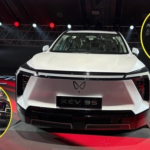Recibe las noticias más leídas de la semana directamente en tu email
Respetamos tu privacidad. Puedes darte de baja en cualquier momento.
China advances towards an energy model where electric cars cease to be mere vehicles and become allies of the grid. The country is testing bidirectional charging stations capable of receiving and returning electricity according to system needs. The initiative seeks to balance consumption and reduce pressure on fossil sources.
The proposal replicates the compensation mechanism used in homes with solar panels. Instead of returning solar surpluses, vehicles discharge part of their battery during demand peaks. Tests indicate economic benefits for users, encouraging active participation in the system.
The project includes 30 stations distributed across nine cities. The goal is to reach thousands of points by 2027 and scale to massive capacity before 2030, leveraging the country’s enormous electric fleet.
China has more than forty million electric cars, and this magnitude opens the door to forming the largest mobile battery network on the planet. Its coordinated use would allow diversifying energy sources and strengthening the stability of a system that still depends on coal.
The approach is not entirely new. More than a hundred similar projects have been tested in different regions of the world. However, none have managed to advance towards the national adoption that China aims to achieve in a few years.
The challenge is ambitious, but the government maintains that a network of connected vehicles could become a pillar to accelerate the ecological transition and reduce the country’s climatic footprint.
Bidirectional charging requires more expensive technologies than conventional chargers. The cost is three times that of standard systems, hindering its expansion in markets where state investment is limited. In China, the policy of energy subsidies allows for faster progress.
Another drawback is the lack of compatibility between vehicles. Currently, only some models can participate in the system, which delays its mass adoption. Added to this is the concern about battery degradation, a factor that makes many drivers hesitate.
Even so, the pace of innovation suggests that these obstacles could be reduced. The arrival of new technologies and standardization would allow more users to integrate into the model.
The use of electric cars as distributed batteries helps reduce dependence on thermal power plants during peak consumption hours. This avoids resorting to peaks of generation based on fossil fuels and decreases global emissions.
The system allows taking advantage of energy produced during low demand times, which improves overall efficiency and reduces energy waste. Each contribution helps stabilize the grid, reducing the need for additional infrastructure.
Moreover, strengthening a more flexible grid favors the integration of renewable energies, especially solar and wind, whose supply varies with the weather. The model turns electric mobility into an active player against the climate crisis.
The country seeks to establish itself as an “electrostate,” capable of transforming production and energy use through massive infrastructures and emerging technologies. Bidirectional charging is part of a strategy that includes solar megaprojects and large hydraulic works.
The rapid expansion of electric mobility and investment in smart systems position China as a leader in environmental innovation. Its goal is to reconfigure the energy matrix and reduce coal dependence in the medium term.
Although it still faces enormous challenges, the country is accelerating initiatives that could change the global energy landscape and redefine the role of electric vehicles in the ecological transition.
Compartí esta nota
Director/Propietario:
Luis Pavesio
Registro DNDA en trámite
Fecha: 27/11/2025
N° de Edición: 4806
2022 © Noticias Ambientales | Todos los derechos reservados.












